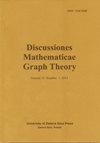笛卡尔积中全互可见数为零的图和全互可见图
IF 0.8
4区 数学
Q3 MATHEMATICS
引用次数: 7
摘要
如果$G$是图并且$X\substeqV(G)$,那么$X$是一个全互可见性集,如果$G美元的每对顶点$X$和$y$都允许一个最短的$X,y$路径$P$与$V(P)\cap X\ssubsteq\{X,y\}$。$G$的最大总互可见性集合的基数是$G$中的总互可见性数$\mu_{\rmt}(G)$。具有$\mu_{\rmt}(G)=0$的图被刻画为其中没有顶点是凸$P_3$的中心顶点的图。笛卡儿乘积的总互可见性是有界的,并证明了几个精确的结果。例如,$\mu_{\rm t}(K_n\,\square\,K_m)=\max\{n,m\}$和$\mu_{\rm t}(t\,\square\,H)=\mu_{\rm t}(t)\mu_(\rm t)(H)$,其中$t$是树,$H$是任意图。还证明了$\mu_{\rmt}(G\,\ square \,H)$可以是大于$\mu_{\rmt}(G)\mu_{\rmt}(H)$的任意值。本文章由计算机程序翻译,如有差异,请以英文原文为准。
Graphs with total mutual-visibility number zero and total mutual-visibility in Cartesian products
If $G$ is a graph and $X\subseteq V(G)$, then $X$ is a total mutual-visibility set if every pair of vertices $x$ and $y$ of $G$ admits a shortest $x,y$-path $P$ with $V(P) \cap X \subseteq \{x,y\}$. The cardinality of a largest total mutual-visibility set of $G$ is the total mutual-visibility number $\mu_{\rm t}(G)$ of $G$. Graphs with $\mu_{\rm t}(G) = 0$ are characterized as the graphs in which no vertex is the central vertex of a convex $P_3$. The total mutual-visibility number of Cartesian products is bounded and several exact results proved. For instance, $\mu_{\rm t}(K_n\,\square\, K_m) = \max\{n,m\}$ and $\mu_{\rm t}(T\,\square\, H) = \mu_{\rm t}(T)\mu_{\rm t}(H)$, where $T$ is a tree and $H$ an arbitrary graph. It is also demonstrated that $\mu_{\rm t}(G\,\square\, H)$ can be arbitrary larger than $\mu_{\rm t}(G)\mu_{\rm t}(H)$.
求助全文
通过发布文献求助,成功后即可免费获取论文全文。
去求助
来源期刊

Discussiones Mathematicae Graph Theory
MATHEMATICS-
CiteScore
2.20
自引率
0.00%
发文量
22
审稿时长
53 weeks
期刊介绍:
The Discussiones Mathematicae Graph Theory publishes high-quality refereed original papers. Occasionally, very authoritative expository survey articles and notes of exceptional value can be published. The journal is mainly devoted to the following topics in Graph Theory: colourings, partitions (general colourings), hereditary properties, independence and domination, structures in graphs (sets, paths, cycles, etc.), local properties, products of graphs as well as graph algorithms related to these topics.
 求助内容:
求助内容: 应助结果提醒方式:
应助结果提醒方式:


